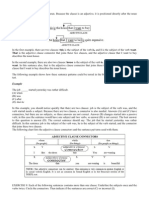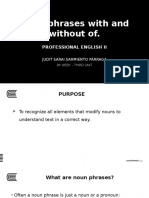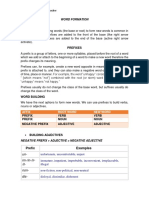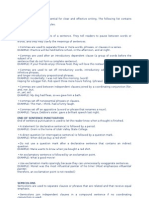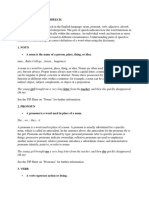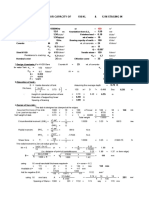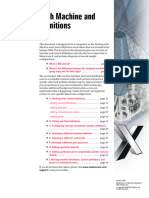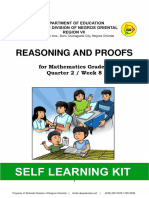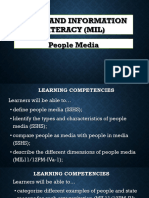The Eight Parts of Speech
The Eight Parts of Speech
Uploaded by
Tin ListancoCopyright:
Available Formats
The Eight Parts of Speech
The Eight Parts of Speech
Uploaded by
Tin ListancoOriginal Title
Copyright
Available Formats
Share this document
Did you find this document useful?
Is this content inappropriate?
Copyright:
Available Formats
The Eight Parts of Speech
The Eight Parts of Speech
Uploaded by
Tin ListancoCopyright:
Available Formats
THE EIGHT PARTS OF SPEECH
There are eight parts of speech in the English language: noun, pronoun, verb, adjective,
adverb, preposition, conjunction, and interjection. The part of speech indicates how the word
functions in meaning as well as grammatically within the sentence. An individual word can
function as more than one part of speech when used in different circumstances. Understanding
parts of speech is essential for determining the correct definition of a word when using the
dictionary.
1. NOUN
A noun is the name of a person, place, thing, or idea.
man... Manila... house... happiness
A noun is a word for a person, place, thing, or idea. Nouns are often used with an article
(the, a, an), but not always. Proper nouns always start with a capital letter; common nouns do
not. Nouns can be singular or plural, concrete or abstract. Nouns show possession by
adding 's. Nouns can function in different roles within a sentence; for example, a noun can be a
subject, direct object, indirect object, subject complement, or object of a preposition.
The young girl brought me a very long letter from the teacher, and then she quickly
disappeared. Oh my!
2. PRONOUN
A pronoun is a word used in place of a noun.
She... we... they... it
A pronoun is a word used in place of a noun. A pronoun is usually substituted for a specific
noun, which is called its antecedent. In the sentence above, the antecedent for the
pronoun she is the girl. Pronouns are further defined by type: personal pronouns refer to
specific persons or things; possessive pronouns indicate ownership; reflexive pronouns are used
to emphasize another noun or pronoun; relative pronouns introduce a subordinate clause; and
demonstrative pronouns identify, point to, or refer to nouns.
The young girl brought me a very long letter from the teacher, and then she quickly
disappeared. Oh my!
3. VERB
A verb expresses action or being.
jump... is... write... become
The verb in a sentence expresses action or being. There is a main verb and sometimes one or
more helping verbs. ("She can sing." Sing is the main verb; can is the helping verb.) A verb
must agree with its subject in number (both are singular or both are plural). Verbs also take
different forms to express tense.
The young girl brought me a very long letter from the teacher, and then she
quickly disappeared. Oh my!
4. ADJECTIVE
An adjective modifies or describes a noun or pronoun.
pretty... old... blue... smart
An adjective is a word used to modify or describe a noun or a pronoun. It usually answers the
question of which one, what kind, or how many. (Articles [a, an, the] are usually classified as
adjectives.)
The young girl brought me a very long letter from the teacher, and then she quickly
disappeared. Oh my!
5. ADVERB
An adverb modifies or describes a verb, an adjective, or another adverb.
gently... extremely... carefully... well
An adverb describes or modifies a verb, an adjective, or another adverb, but never a noun. It
usually answers the questions of when, where, how, why, under what conditions, or to what
degree. Adverbs often end in -ly.
The young girl brought me a very long letter from the teacher,
and then she quickly disappeared. Oh my!
6. PREPOSITION
A preposition is a word placed before a noun or pronoun to form a phrase
modifying another word in the sentence.
by... with.... about... until
(by the tree, with our friends, about the book, until tomorrow)
A preposition is a word placed before a noun or pronoun to form a phrase modifying another
word in the sentence. Therefore a preposition is always part of a prepositional phrase. The
prepositional phrase almost always functions as an adjective or as an adverb. The following list
includes the most common prepositions:
The young girl brought me a very long letter from the teacher, and then she quickly
disappeared. Oh my!
7. CONJUNCTION
A conjunction joins words, phrases, or clauses.
and... but... or... while... because
A conjunction joins words, phrases, or clauses, and indicates the relationship between the
elements joined. Coordinating conjunctions connect grammatically equal elements: and, but, or,
nor, for, so, yet. Subordinating conjunctions connect clauses that are not equal: because,
although, while, since, etc. There are other types of conjunctions as well.
The young girl brought me a very long letter from the teacher, and then she quickly
disappeared. Oh my!
8. INTERJECTION
An interjection is a word used to express emotion.
Oh!... Wow!... Oops!
An interjection is a word used to express emotion. It is often followed by an exclamation point.
The young girl brought me a very long letter from the teacher, and then she quickly
disappeared. Oh my!
You might also like
- 07sketches Volume 3 PDFDocument17 pages07sketches Volume 3 PDFAlfredo Moreno100% (3)
- Expedia Travel Confirmation - 12 Dec - (Itinerary # 133540733412) PDFDocument1 pageExpedia Travel Confirmation - 12 Dec - (Itinerary # 133540733412) PDFAgeum Lagirdam Poj100% (1)
- PTCL Dissconnection ApplicationDocument1 pagePTCL Dissconnection ApplicationSh Mati Elahi59% (44)
- Writing Task 1 - Sam VarleyDocument64 pagesWriting Task 1 - Sam Varleytrangle2609No ratings yet
- Tugas Type of CompoundsDocument10 pagesTugas Type of CompoundsNensiNo ratings yet
- IGC Code Changes PDFDocument3 pagesIGC Code Changes PDFswarg vibha100% (1)
- Coherence in WritingDocument23 pagesCoherence in WritingBafsk100% (1)
- Clauses and PhrasesDocument13 pagesClauses and PhrasesFatïma ZohraNo ratings yet
- Determiners in English Grammar With Examples PDFDocument4 pagesDeterminers in English Grammar With Examples PDFhemisphereph2981100% (2)
- L3 CohesionDocument11 pagesL3 CohesionRobert TsuiNo ratings yet
- Promoting Awareness of Teaching Collocations Techniques To Beginners (Adjective-Noun Collocations)Document8 pagesPromoting Awareness of Teaching Collocations Techniques To Beginners (Adjective-Noun Collocations)andreaetang100% (1)
- 7 Grammar Rules You Need To Get A Higher IELTS Score - FluentU IELTS BlogDocument19 pages7 Grammar Rules You Need To Get A Higher IELTS Score - FluentU IELTS Blogmandaliya umeshNo ratings yet
- Cohesion - Linking Words and PhrasesDocument2 pagesCohesion - Linking Words and PhrasesVince Vo67% (3)
- CollocationDocument23 pagesCollocationCamila AlferesNo ratings yet
- Idioms Complete Collection PDFDocument66 pagesIdioms Complete Collection PDFSindh Madaressat Ul IslamNo ratings yet
- Think of Word That Best Describe You, Constract A 4-5 Sentences Why? Be Ready To Recite ItDocument38 pagesThink of Word That Best Describe You, Constract A 4-5 Sentences Why? Be Ready To Recite ItRoselyn L. Dela Cruz100% (1)
- Sentence Structure in EnglishDocument2 pagesSentence Structure in EnglishvanjushkaNo ratings yet
- Sentences: Independent Clauses Act As Complete Sentences, While Subordinate Clauses Cannot Stand Alone andDocument9 pagesSentences: Independent Clauses Act As Complete Sentences, While Subordinate Clauses Cannot Stand Alone andThamizhman Mani100% (1)
- An Adjective Clause Describes A NounDocument8 pagesAn Adjective Clause Describes A NounVivi HidayantiNo ratings yet
- 1 MonthsDocument20 pages1 Monthsulfah fahsyaNo ratings yet
- Decoding of English Idioms by Ta Miles L LearnersDocument15 pagesDecoding of English Idioms by Ta Miles L LearnersiamkuttyNo ratings yet
- Noun Phrases With and Without Of.: Professional English IiDocument36 pagesNoun Phrases With and Without Of.: Professional English IiGASUNo ratings yet
- Clauses in English Grammar With Examples PDFDocument6 pagesClauses in English Grammar With Examples PDFhemisphereph2981No ratings yet
- Chart of All Tenses PDFDocument1 pageChart of All Tenses PDFIrfan Vadtala100% (1)
- Linguistics 1Document29 pagesLinguistics 1Hakkuo AmeNo ratings yet
- Prepositional PhraseDocument5 pagesPrepositional PhraseMar Nie Morales ForcadillaNo ratings yet
- Transition WordsDocument14 pagesTransition WordsTherese Canapi100% (2)
- AdjectivesDocument42 pagesAdjectivesAngelica RicoNo ratings yet
- Affixes and Roots: Word FormationDocument7 pagesAffixes and Roots: Word FormationMcJftNo ratings yet
- Sentence StructureDocument114 pagesSentence StructurePrabavathi PappuNo ratings yet
- Englsh CollocationErrors PDFDocument9 pagesEnglsh CollocationErrors PDFpatitentNo ratings yet
- Phuket IELTS Clinic - IELTS Writing - Discussion Essay - Do I Give My OpinionDocument3 pagesPhuket IELTS Clinic - IELTS Writing - Discussion Essay - Do I Give My OpinionamritjosanNo ratings yet
- Sentence CorrectionDocument6 pagesSentence CorrectionGhulam Mustafa RoonjhaNo ratings yet
- Academic Phrasebank - Introducing WorkDocument4 pagesAcademic Phrasebank - Introducing WorkFernanda Cristina Cervantes YamauraNo ratings yet
- Pronunciation Notes (Charis SIL)Document3 pagesPronunciation Notes (Charis SIL)Haider MuhammedNo ratings yet
- Commas: And, Nor, But, Or, Yet, So)Document4 pagesCommas: And, Nor, But, Or, Yet, So)khari_ramoNo ratings yet
- Task 1Document26 pagesTask 1FarhanNo ratings yet
- English BookDocument121 pagesEnglish BookRaaghul RaviNo ratings yet
- Business Communication in An OrganizationDocument25 pagesBusiness Communication in An OrganizationAbhijeet AgarwalNo ratings yet
- ADJECTIVES Natasha - ValentinaDocument14 pagesADJECTIVES Natasha - ValentinaNurian Xiomara PardoNo ratings yet
- What Is Vocabulary?Document18 pagesWhat Is Vocabulary?VadodaraNo ratings yet
- The Use of Verb Noun Collocations in Writing StoriDocument7 pagesThe Use of Verb Noun Collocations in Writing StoriMa Minh HươngNo ratings yet
- Шпаргалка по грамматике английского языкаDocument11 pagesШпаргалка по грамматике английского языкаDasha Vafina100% (1)
- What Is Modifiers PDFDocument10 pagesWhat Is Modifiers PDFYash HriddhaNo ratings yet
- Etymological Survey of The English Word-StockDocument6 pagesEtymological Survey of The English Word-StockБекасыл БалпанкулNo ratings yet
- FOMS Week 2 Academic WritingDocument25 pagesFOMS Week 2 Academic WritingMuhammad HusnainNo ratings yet
- 5 Tips To Make Constructing English Sentences EasyDocument11 pages5 Tips To Make Constructing English Sentences EasyGlen Mark Macario100% (1)
- Academic WritingDocument27 pagesAcademic WritingShinie100% (3)
- Guessing The Meaning From Context 2013Document16 pagesGuessing The Meaning From Context 2013Porntip Bodeepongse รักในหลวง100% (1)
- Relative ClausesDocument4 pagesRelative ClausesAlex ZaragozaNo ratings yet
- Letter WritingDocument12 pagesLetter WritingNarasinga Rao BarnikanaNo ratings yet
- Corpus IntroductionDocument22 pagesCorpus IntroductionChao XuNo ratings yet
- VocabularyDocument9 pagesVocabularyHenry NapitupuluNo ratings yet
- How To Improve Your LEVEL of IELTS Score You WantDocument28 pagesHow To Improve Your LEVEL of IELTS Score You WantChrisGovasNo ratings yet
- English Study MaterialDocument70 pagesEnglish Study MaterialSymon RoyNo ratings yet
- How To Use A DictonaryDocument4 pagesHow To Use A DictonaryCrisPopNo ratings yet
- Ellipsis and SubstitutionDocument12 pagesEllipsis and Substitutionélton100% (1)
- Grammar Point ExplanationDocument4 pagesGrammar Point ExplanationfarlynzNo ratings yet
- Vocabulary For The IELTSDocument76 pagesVocabulary For The IELTSHoa huynh hoaNo ratings yet
- 7a0b9 PPT Materi Part of Speech NowraDocument11 pages7a0b9 PPT Materi Part of Speech NowraM altaf GhazaliNo ratings yet
- The Eight Parts of SpeechDocument3 pagesThe Eight Parts of SpeechmicaNo ratings yet
- Materi Part of SpeechDocument11 pagesMateri Part of Speechtaufan2017No ratings yet
- The Eight Parts of SpeechDocument3 pagesThe Eight Parts of SpeechOnel1No ratings yet
- TIP Sheet (Parts of Speech)Document4 pagesTIP Sheet (Parts of Speech)Alishan ArshadNo ratings yet
- Obituary Kiyoshi MutoDocument1 pageObituary Kiyoshi Mutokiert.sahasakNo ratings yet
- PN1 Shakti Akshaya S PDFDocument60 pagesPN1 Shakti Akshaya S PDFRekha Rajaram100% (2)
- W.E Project - Topic - Electric CellDocument4 pagesW.E Project - Topic - Electric Celldrphysics256No ratings yet
- Over Head Tank - Circular Flat SlabDocument14 pagesOver Head Tank - Circular Flat SlabVi Jay100% (1)
- Graphene AerogelDocument22 pagesGraphene AerogelRohit Ahire100% (1)
- Syllabus of B.a.ll.B 2nd SEMESTER Pol. Sci.Document3 pagesSyllabus of B.a.ll.B 2nd SEMESTER Pol. Sci.Akshit AwasthiNo ratings yet
- Astm D7700 15Document1 pageAstm D7700 15Samer MohamedNo ratings yet
- FINAL Chapter 6 Conical Dryer 1Document16 pagesFINAL Chapter 6 Conical Dryer 1Milton Dels RosaNo ratings yet
- SD160 Installation and Administrator's GuideDocument90 pagesSD160 Installation and Administrator's GuideesaumvNo ratings yet
- Node and Supernode Final 2Document10 pagesNode and Supernode Final 2Ellen Kay CacatianNo ratings yet
- EeeeeeDocument9 pagesEeeeeeamelia99No ratings yet
- Expanplast SRDocument3 pagesExpanplast SRAmar Wadood KhanNo ratings yet
- Deadzone 3.0 Rebels 100pt ListDocument3 pagesDeadzone 3.0 Rebels 100pt ListchinksterNo ratings yet
- TNA Form OAP NCIIDocument10 pagesTNA Form OAP NCIIRonnie NaagNo ratings yet
- Working With MD CD-1 1-11Document11 pagesWorking With MD CD-1 1-11Neel DNo ratings yet
- Direct Pronouns: The in Italian AreDocument2 pagesDirect Pronouns: The in Italian AreFederica MarrasNo ratings yet
- Demonstrative Adjectives and PronounsDocument4 pagesDemonstrative Adjectives and PronounsBrenda AlemanNo ratings yet
- Math 8 Q2 Week 8Document17 pagesMath 8 Q2 Week 8Arniel Kharl SanoyNo ratings yet
- Customer Resistance Towards Internet BankingDocument6 pagesCustomer Resistance Towards Internet Bankingadipoliachayan5235No ratings yet
- Konsumsi Zat Gizi Dan Daya Terima Pasien Rawat Inap Penyakit Ginjal Kronik Terhadap Makanan Yang Disajikan Rsup Fatmawati Fatma SilvianiDocument96 pagesKonsumsi Zat Gizi Dan Daya Terima Pasien Rawat Inap Penyakit Ginjal Kronik Terhadap Makanan Yang Disajikan Rsup Fatmawati Fatma SilvianiBalqis AuraNo ratings yet
- Ed - 3Document81 pagesEd - 3JaiNo ratings yet
- ART 101 ART101 Week 3 Assignment Formal Analysis of ArtDocument4 pagesART 101 ART101 Week 3 Assignment Formal Analysis of ArtJosh SandersNo ratings yet
- People MediaDocument42 pagesPeople Mediaadrianeenerva0No ratings yet
- Gas Property CalculationsDocument37 pagesGas Property CalculationszirimiaNo ratings yet
- Yak 42Document12 pagesYak 42AlexandraAndreeaNo ratings yet
- Step & Touch Testing KitDocument4 pagesStep & Touch Testing KitkashifNo ratings yet


















